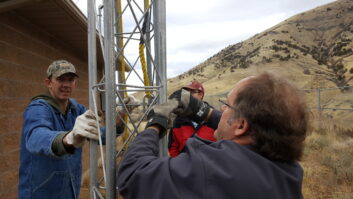In the first and second parts of this series, we outlined the scope of small power generators, how they do what they do, general factors (plus and minus) that affect their performance, and the criteria for sizing and optimal type.
In this installment, we’ll begin to annotate the litany of practical items that should enhance safety, performance, reliability and overall satisfaction.

IT WAS A DARK AND STORMY NIGHT
So, darkness has come.
The storm, the flood, the winds, the unpaid electric bill (just kidding about the bill) … the foreseen but unwelcome calamity has now arrived, and commercial power has been lost at your station.
When the moment is safe, you glance outside and know that this is worse than you thought, as it is totally dark from horizon to horizon.
In the relative blaze of the building emergency lights, you locate your trusty flashlight and headlamp in their trickle chargers. You unlock the fireproof storage shed behind the studio and roll out “old reliable” to the pre-prepared operating location.
You’re of the mind that there is no such thing as too much ground, so you connect up the generator frame ground cable to the rod you’ve hammered in. Next comes the SJO power cable that you’ve stored in a convenient warm place so this important connection is flexible and supple enough to roll out flat and straight.
This main umbilical of life for your station is ultra-bright yellow or orange (or both) so that no one will trip or (hopefully) drive over it. A few big traffic cones are additional safety markers and make you and your generator look dramatic and important!
All plugs and receptacles are twist-lock type, so everything goes together quickly and accurately.
Since you exercise the generator for at least 20 minutes every month and under load every six months, this mighty-mini starts in just a few seconds. Within the minute it takes to walk inside, the generator is ready to take a load. You throw the switch on the manual transfer switch, and voilà — your station has come back to life, albeit in an abbreviated form.
As we noted in the last episode, prudent selection of gear and features should allow your station to provide near continuous, meaningful service to your community.
A good friend, for whom pragmatism is one of his greatest assets, calls these select items …
THE RACK OF LAST RESORT
One of my most learned mentors had a great adage: Any item in the mainstream of your business is critical and worthy of your complete attention.
Our fictitious little power plant, critical at this moment, started on the first attempt because all the little details had been addressed. Periodic maintenance is absolutely necessary such as the exercise routine mentioned above. Proper fuel storage might be evaluated as the second most important focus.
As the vast majority of these small portable units run on gasoline, remember that unpressurized gasoline evaporates, leaving a residue of caulk-like material similar in many ways to turpentine. As a bonus, periodic exercise burns off some of the onboard fuel, precipitating replacement of fuel over time. But more aggressive fuel discipline is needed, such as a fuel stabilizer additive. Usually the engine manufacturer will provide selection guidance in the instruction manual, sometimes as specific as their approved and tested additive choices.
“Stale” fuel is deleterious to small engines for a great number of reasons, including hard starting, residual material in the fuel system components such as the carburetor, low engine power output, etc. Also keep in mind that gasoline and most liquid petroleum products have solvent properties and will dissolve paint, more solid oils, wood products and the like. These alien materials will travel along with the gas in a suspended state, landing wherever they want. Clean, fresh gas is essential.
Do not forget to treat any additional fuel stored on site in a similar manner (extra five-gallon cans or tanks perhaps), and check this backup fuel whenever you exercise the generator.
Gasoline and most volatile gases are explosive in nature and demand special, attentive handling. For this reason, never fuel the generator while it is running or in a highly heated condition!
Also, most of these small generators are air-cooled and so have many extremely hot points on them, such as the muffler, cylinder heads, crankcase, etc. Burns are very bad injuries and are slow to heal. It’s best to avoid them. Be safe, be careful, take precautions … stay healthy and alive!
After fuel, lubricating oil is probably the next most important maintenance item.
Oil in an engine has four principle functions:
• The obvious lubrication of moving parts
• Transfer and dispersal of both mechanical action heat and waste combustion heat
• The suspension of any loose material such as scrapping from piston rings
• The absorption of the acid waste products from combustion
Changing the oil (and the filter if there is one) on a regular, short-term basis is the single most cost-effective action you can take to extend the life and the reliability of your generator.
Your instruction book will tell you how quickly you need to get the original “break-in” oil out of the engine. Some vendors want that first oil out after 10 hours, and some after 25 hours. A few manufacturers run the engine in the factory for 5 or 10 hours under load, disposing of that oil and shipping the engine dry. In this case, your first change for these units, since this oil service is actually the second, can take place much later.
Always change the oil after an extended run. If your calamity has the generator running for more than six hours, the cost of a quart or so of oil for the change is miniscule in the scheme of total expenses.

Follow the instruction book’s recommendation on oil viscosity. The immediate reaction is that multi-grade or high performance synthetic would be better, but your generator engine has different challenges than your car.
For example, the generator runs at one speed, and after a few moments, at one temperature for sometimes days at a time. Your car has to change speeds rapidly, idle in traffic, scream down the road at ultra-high speeds (I’m thinking here of my riding experiences with our editor, Cris Alexander), so an engineered blend of something like 5W-40 meets the needs of a car. Probably SAE 30 is the best compromise choice for your generator.
LOCATION, LOCATION, LOCATION!
Your generator needs a planned location in which to operate. Three principle factors focus the choice:
• Safety of personnel and the equipment
• Proper dispersal of heat and exhaust
• Noise for both personnel comfort and isolation from open mics
The generator needs to be kept out of the way of vehicular traffic and must not restrict access, such as just outside the building blocking a fire exit. Use a large modicum of common sense in your location decision, and don’t yield to pressure, such as operating it in the foyer or inside a garage (even with the roll-up door open).
Combustion byproducts are toxic, and even though just a fraction of a car or truck engine, the emissions from these little tempests are nowhere near as clean as those from your vehicle. Exhaust from these little wonders can fill a room to dangerous limits in a few minutes. Similar semi-enclosed spaces, such as a low-roof loading dock, are in the same category. Stairwells are another really bad choice.
On the one hand, you have exhaust to disperse, and on the other hand, you need a lot of fresh air for combustion. Wide open spaces work best for both demands.
Also, exhaust gases are very hot, so you should avoid sending these gases towards anything combustible. A few moments, even that 20 minutes of monthly exercise, is nothing compared to eight hours or a day of continuous operation. In the heat of summer, with a generator operating for 24 hours, I’ve seen the exhaust melt paint 20 feet away towards the end of the run.
The effectiveness of the mufflers on these units to reduce noise varies widely, as the back-pressure exerted by them influences power performance. A critical or hospital-grade muffler is best if minimal noise is needed. Some states, where brush fires and other similar circumstances are extent, require the muffler to be of the spark reduction type.
In the final analysis, open space and distance is the best guidance for generator placement.
Remember, though, if your power cable exceeds 100 feet in total length from power plant to use, GEP guides us to upsize the cable wire by one wire size. An example: AWG #10 stranded is often used for a 5 kW unit with a nominal 30 amps per phase output. If your generator position is at the far side of the parking lot behind the concrete enclosure for the dumpster some 150 ft. away, increase you cable size to #8.
As mentioned, the devil is in the details, and the minutia is endless on the subject of small power plants. That said, we are going to wrap it up in a last, comprehensive installment next issue.
Comments, criticism, suggestions and/or questions are welcome. Please send them along and we’ll address them before we close. Email rwee@futurenet.com with “generators” in the subject field.
Charles “Buc” Fitch, P.E. is a registered professional consultant engineer, senior member of the SBE, lifetime CPBE with AMD, licensed electrical contractor, former station owner and former director of engineering.








